Major Health and Lifestyle Issues
VerifiedAdded on 2023/06/15
|11
|3340
|275
AI Summary
This report discusses major health and lifestyle issues such as cancer, cardiovascular disease, smoking, and physical activity. It explains the causes, symptoms, and risks associated with these issues. The report also covers the government's strategies and interventions to tackle these issues, including the Global Action Plan for the Prevention and Control of Non-communicable Diseases 2013-2020 and the Cardiovascular Disease Outcomes Strategy. The interventions include population-wide and individual interventions, such as healthy school meals, taxes on unhealthy foods, and targeted interventions for hypercholesterolemia and hypertension.
Contribute Materials
Your contribution can guide someone’s learning journey. Share your
documents today.

RUNNING HEAD: Major Health and Lifestyle Issues
Major Health and Lifestyle Issues
Major Health and Lifestyle Issues
Secure Best Marks with AI Grader
Need help grading? Try our AI Grader for instant feedback on your assignments.
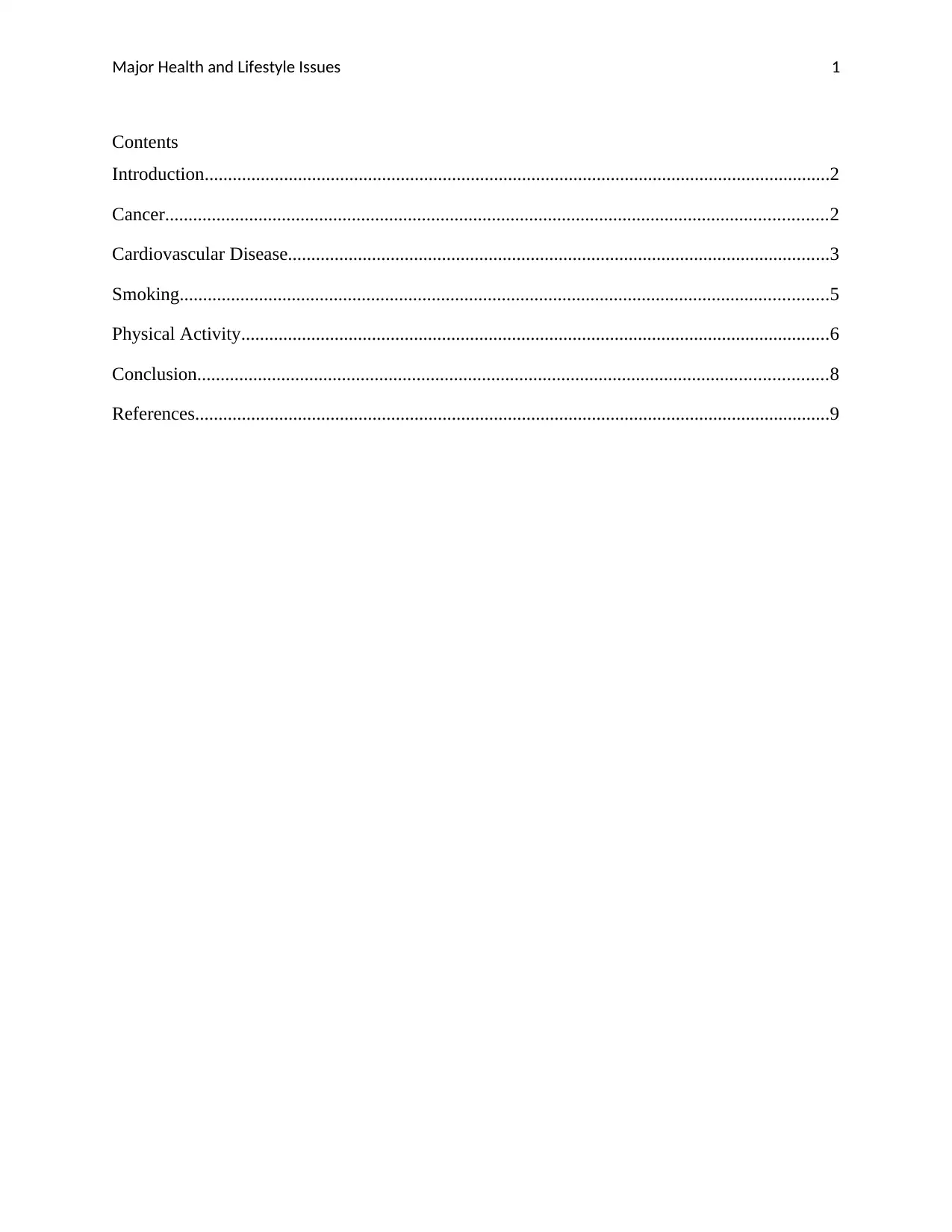
Major Health and Lifestyle Issues 1
Contents
Introduction......................................................................................................................................2
Cancer..............................................................................................................................................2
Cardiovascular Disease....................................................................................................................3
Smoking...........................................................................................................................................5
Physical Activity..............................................................................................................................6
Conclusion.......................................................................................................................................8
References........................................................................................................................................9
Contents
Introduction......................................................................................................................................2
Cancer..............................................................................................................................................2
Cardiovascular Disease....................................................................................................................3
Smoking...........................................................................................................................................5
Physical Activity..............................................................................................................................6
Conclusion.......................................................................................................................................8
References........................................................................................................................................9
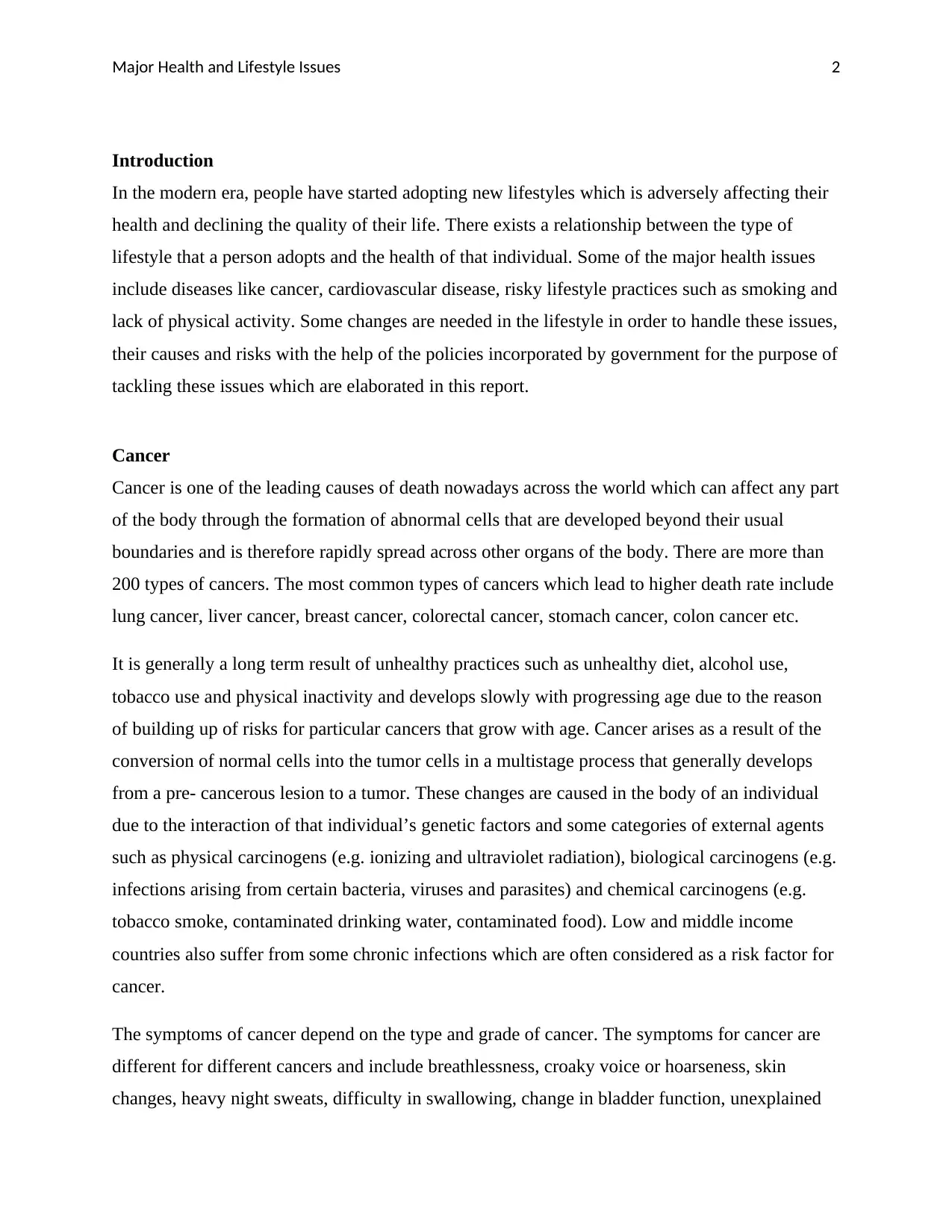
Major Health and Lifestyle Issues 2
Introduction
In the modern era, people have started adopting new lifestyles which is adversely affecting their
health and declining the quality of their life. There exists a relationship between the type of
lifestyle that a person adopts and the health of that individual. Some of the major health issues
include diseases like cancer, cardiovascular disease, risky lifestyle practices such as smoking and
lack of physical activity. Some changes are needed in the lifestyle in order to handle these issues,
their causes and risks with the help of the policies incorporated by government for the purpose of
tackling these issues which are elaborated in this report.
Cancer
Cancer is one of the leading causes of death nowadays across the world which can affect any part
of the body through the formation of abnormal cells that are developed beyond their usual
boundaries and is therefore rapidly spread across other organs of the body. There are more than
200 types of cancers. The most common types of cancers which lead to higher death rate include
lung cancer, liver cancer, breast cancer, colorectal cancer, stomach cancer, colon cancer etc.
It is generally a long term result of unhealthy practices such as unhealthy diet, alcohol use,
tobacco use and physical inactivity and develops slowly with progressing age due to the reason
of building up of risks for particular cancers that grow with age. Cancer arises as a result of the
conversion of normal cells into the tumor cells in a multistage process that generally develops
from a pre- cancerous lesion to a tumor. These changes are caused in the body of an individual
due to the interaction of that individual’s genetic factors and some categories of external agents
such as physical carcinogens (e.g. ionizing and ultraviolet radiation), biological carcinogens (e.g.
infections arising from certain bacteria, viruses and parasites) and chemical carcinogens (e.g.
tobacco smoke, contaminated drinking water, contaminated food). Low and middle income
countries also suffer from some chronic infections which are often considered as a risk factor for
cancer.
The symptoms of cancer depend on the type and grade of cancer. The symptoms for cancer are
different for different cancers and include breathlessness, croaky voice or hoarseness, skin
changes, heavy night sweats, difficulty in swallowing, change in bladder function, unexplained
Introduction
In the modern era, people have started adopting new lifestyles which is adversely affecting their
health and declining the quality of their life. There exists a relationship between the type of
lifestyle that a person adopts and the health of that individual. Some of the major health issues
include diseases like cancer, cardiovascular disease, risky lifestyle practices such as smoking and
lack of physical activity. Some changes are needed in the lifestyle in order to handle these issues,
their causes and risks with the help of the policies incorporated by government for the purpose of
tackling these issues which are elaborated in this report.
Cancer
Cancer is one of the leading causes of death nowadays across the world which can affect any part
of the body through the formation of abnormal cells that are developed beyond their usual
boundaries and is therefore rapidly spread across other organs of the body. There are more than
200 types of cancers. The most common types of cancers which lead to higher death rate include
lung cancer, liver cancer, breast cancer, colorectal cancer, stomach cancer, colon cancer etc.
It is generally a long term result of unhealthy practices such as unhealthy diet, alcohol use,
tobacco use and physical inactivity and develops slowly with progressing age due to the reason
of building up of risks for particular cancers that grow with age. Cancer arises as a result of the
conversion of normal cells into the tumor cells in a multistage process that generally develops
from a pre- cancerous lesion to a tumor. These changes are caused in the body of an individual
due to the interaction of that individual’s genetic factors and some categories of external agents
such as physical carcinogens (e.g. ionizing and ultraviolet radiation), biological carcinogens (e.g.
infections arising from certain bacteria, viruses and parasites) and chemical carcinogens (e.g.
tobacco smoke, contaminated drinking water, contaminated food). Low and middle income
countries also suffer from some chronic infections which are often considered as a risk factor for
cancer.
The symptoms of cancer depend on the type and grade of cancer. The symptoms for cancer are
different for different cancers and include breathlessness, croaky voice or hoarseness, skin
changes, heavy night sweats, difficulty in swallowing, change in bladder function, unexplained

Major Health and Lifestyle Issues 3
pains, new moles or changes to a mole, unexplained weight loss, fatigue, unusual lumps, appetite
loss, unusual bleeding, tissue masses, sores that won’t heal, etc.
The International agency for research on cancer has classified some factors which can increase
risk of cancer. These factors can be increase red meat such as beef; lamb and pork are
responsible for the growth of cancer. The cancer has become a major cause of mortality and
morbidity all over the world and has emerged with around 14 million new cases in the year 2012
thereby becoming the second leading reason of death around the globe. There were around 8.8
million deaths caused by cancer in the year 2015 and it is figured out that 1 out of 6 deaths in the
world are a result of cancer these days. The low and middle income countries suffer from 70% of
deaths from cancer due to their lack of affordability for the expensive cancer treatments.
Chemotherapy, hormonal treatment and radiotherapy are some of the cancer treatments which
lead to severe physical effects on the patient such as social and emotional problems including
problems with sleep, fertility problems, feeling exhausted, pain, sickness in the stomach and
vomiting. The patient even suffers from anxiety, depressions, anger, fear and sadness. Moreover,
such therapies also results in the damaging of the bone morrow stem cells and leads to higher
risk of myelodysplasia or acute leukemia i.e. a chance of developing a new cancer.
The government has also undertaken a strategy for achieving world-class cancer outcomes for
England for the year 2015-2020. World Health Organization (WHO) has responded to such
situation through the launch of Global Action Plan for the Prevention and Control of Non-
communicable Diseases 2013-2020 in the year 2013 with the aim to decline the rate of premature
mortality from diseases like cancer, diabetes, cardiovascular diseases and chronic respiratory
diseases by 25% by the year 2025.
The interventions include a national cancer policy within the framework of non- communicable
diseases along with the provision of adequate services for treating the cancer of the patients.
Also, taking steps for preventing the development of cancer at the primary stage is included in
interventions after making proper researches on various cancers with the help of the collection of
data from various sustainable and reliable sources.
pains, new moles or changes to a mole, unexplained weight loss, fatigue, unusual lumps, appetite
loss, unusual bleeding, tissue masses, sores that won’t heal, etc.
The International agency for research on cancer has classified some factors which can increase
risk of cancer. These factors can be increase red meat such as beef; lamb and pork are
responsible for the growth of cancer. The cancer has become a major cause of mortality and
morbidity all over the world and has emerged with around 14 million new cases in the year 2012
thereby becoming the second leading reason of death around the globe. There were around 8.8
million deaths caused by cancer in the year 2015 and it is figured out that 1 out of 6 deaths in the
world are a result of cancer these days. The low and middle income countries suffer from 70% of
deaths from cancer due to their lack of affordability for the expensive cancer treatments.
Chemotherapy, hormonal treatment and radiotherapy are some of the cancer treatments which
lead to severe physical effects on the patient such as social and emotional problems including
problems with sleep, fertility problems, feeling exhausted, pain, sickness in the stomach and
vomiting. The patient even suffers from anxiety, depressions, anger, fear and sadness. Moreover,
such therapies also results in the damaging of the bone morrow stem cells and leads to higher
risk of myelodysplasia or acute leukemia i.e. a chance of developing a new cancer.
The government has also undertaken a strategy for achieving world-class cancer outcomes for
England for the year 2015-2020. World Health Organization (WHO) has responded to such
situation through the launch of Global Action Plan for the Prevention and Control of Non-
communicable Diseases 2013-2020 in the year 2013 with the aim to decline the rate of premature
mortality from diseases like cancer, diabetes, cardiovascular diseases and chronic respiratory
diseases by 25% by the year 2025.
The interventions include a national cancer policy within the framework of non- communicable
diseases along with the provision of adequate services for treating the cancer of the patients.
Also, taking steps for preventing the development of cancer at the primary stage is included in
interventions after making proper researches on various cancers with the help of the collection of
data from various sustainable and reliable sources.
Secure Best Marks with AI Grader
Need help grading? Try our AI Grader for instant feedback on your assignments.
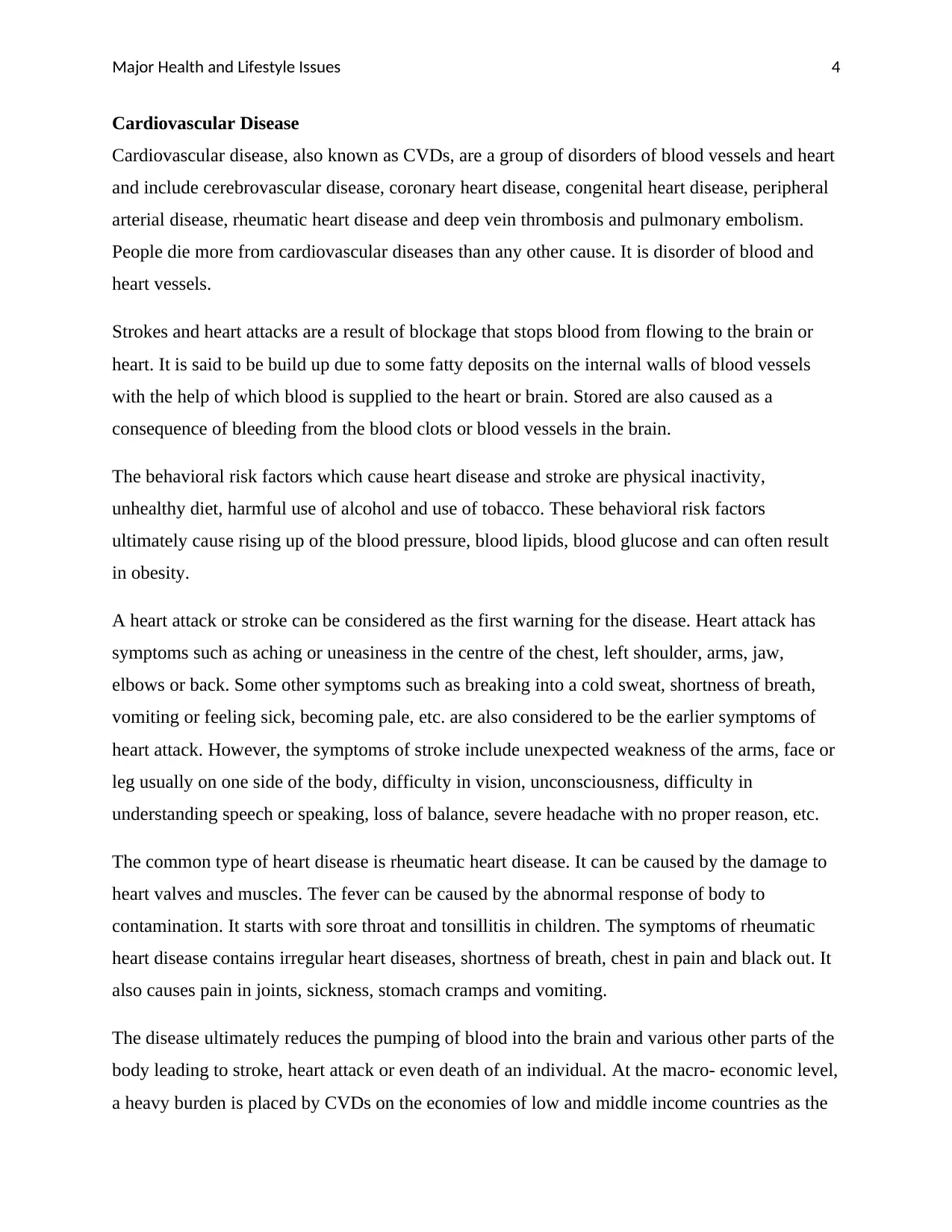
Major Health and Lifestyle Issues 4
Cardiovascular Disease
Cardiovascular disease, also known as CVDs, are a group of disorders of blood vessels and heart
and include cerebrovascular disease, coronary heart disease, congenital heart disease, peripheral
arterial disease, rheumatic heart disease and deep vein thrombosis and pulmonary embolism.
People die more from cardiovascular diseases than any other cause. It is disorder of blood and
heart vessels.
Strokes and heart attacks are a result of blockage that stops blood from flowing to the brain or
heart. It is said to be build up due to some fatty deposits on the internal walls of blood vessels
with the help of which blood is supplied to the heart or brain. Stored are also caused as a
consequence of bleeding from the blood clots or blood vessels in the brain.
The behavioral risk factors which cause heart disease and stroke are physical inactivity,
unhealthy diet, harmful use of alcohol and use of tobacco. These behavioral risk factors
ultimately cause rising up of the blood pressure, blood lipids, blood glucose and can often result
in obesity.
A heart attack or stroke can be considered as the first warning for the disease. Heart attack has
symptoms such as aching or uneasiness in the centre of the chest, left shoulder, arms, jaw,
elbows or back. Some other symptoms such as breaking into a cold sweat, shortness of breath,
vomiting or feeling sick, becoming pale, etc. are also considered to be the earlier symptoms of
heart attack. However, the symptoms of stroke include unexpected weakness of the arms, face or
leg usually on one side of the body, difficulty in vision, unconsciousness, difficulty in
understanding speech or speaking, loss of balance, severe headache with no proper reason, etc.
The common type of heart disease is rheumatic heart disease. It can be caused by the damage to
heart valves and muscles. The fever can be caused by the abnormal response of body to
contamination. It starts with sore throat and tonsillitis in children. The symptoms of rheumatic
heart disease contains irregular heart diseases, shortness of breath, chest in pain and black out. It
also causes pain in joints, sickness, stomach cramps and vomiting.
The disease ultimately reduces the pumping of blood into the brain and various other parts of the
body leading to stroke, heart attack or even death of an individual. At the macro- economic level,
a heavy burden is placed by CVDs on the economies of low and middle income countries as the
Cardiovascular Disease
Cardiovascular disease, also known as CVDs, are a group of disorders of blood vessels and heart
and include cerebrovascular disease, coronary heart disease, congenital heart disease, peripheral
arterial disease, rheumatic heart disease and deep vein thrombosis and pulmonary embolism.
People die more from cardiovascular diseases than any other cause. It is disorder of blood and
heart vessels.
Strokes and heart attacks are a result of blockage that stops blood from flowing to the brain or
heart. It is said to be build up due to some fatty deposits on the internal walls of blood vessels
with the help of which blood is supplied to the heart or brain. Stored are also caused as a
consequence of bleeding from the blood clots or blood vessels in the brain.
The behavioral risk factors which cause heart disease and stroke are physical inactivity,
unhealthy diet, harmful use of alcohol and use of tobacco. These behavioral risk factors
ultimately cause rising up of the blood pressure, blood lipids, blood glucose and can often result
in obesity.
A heart attack or stroke can be considered as the first warning for the disease. Heart attack has
symptoms such as aching or uneasiness in the centre of the chest, left shoulder, arms, jaw,
elbows or back. Some other symptoms such as breaking into a cold sweat, shortness of breath,
vomiting or feeling sick, becoming pale, etc. are also considered to be the earlier symptoms of
heart attack. However, the symptoms of stroke include unexpected weakness of the arms, face or
leg usually on one side of the body, difficulty in vision, unconsciousness, difficulty in
understanding speech or speaking, loss of balance, severe headache with no proper reason, etc.
The common type of heart disease is rheumatic heart disease. It can be caused by the damage to
heart valves and muscles. The fever can be caused by the abnormal response of body to
contamination. It starts with sore throat and tonsillitis in children. The symptoms of rheumatic
heart disease contains irregular heart diseases, shortness of breath, chest in pain and black out. It
also causes pain in joints, sickness, stomach cramps and vomiting.
The disease ultimately reduces the pumping of blood into the brain and various other parts of the
body leading to stroke, heart attack or even death of an individual. At the macro- economic level,
a heavy burden is placed by CVDs on the economies of low and middle income countries as the
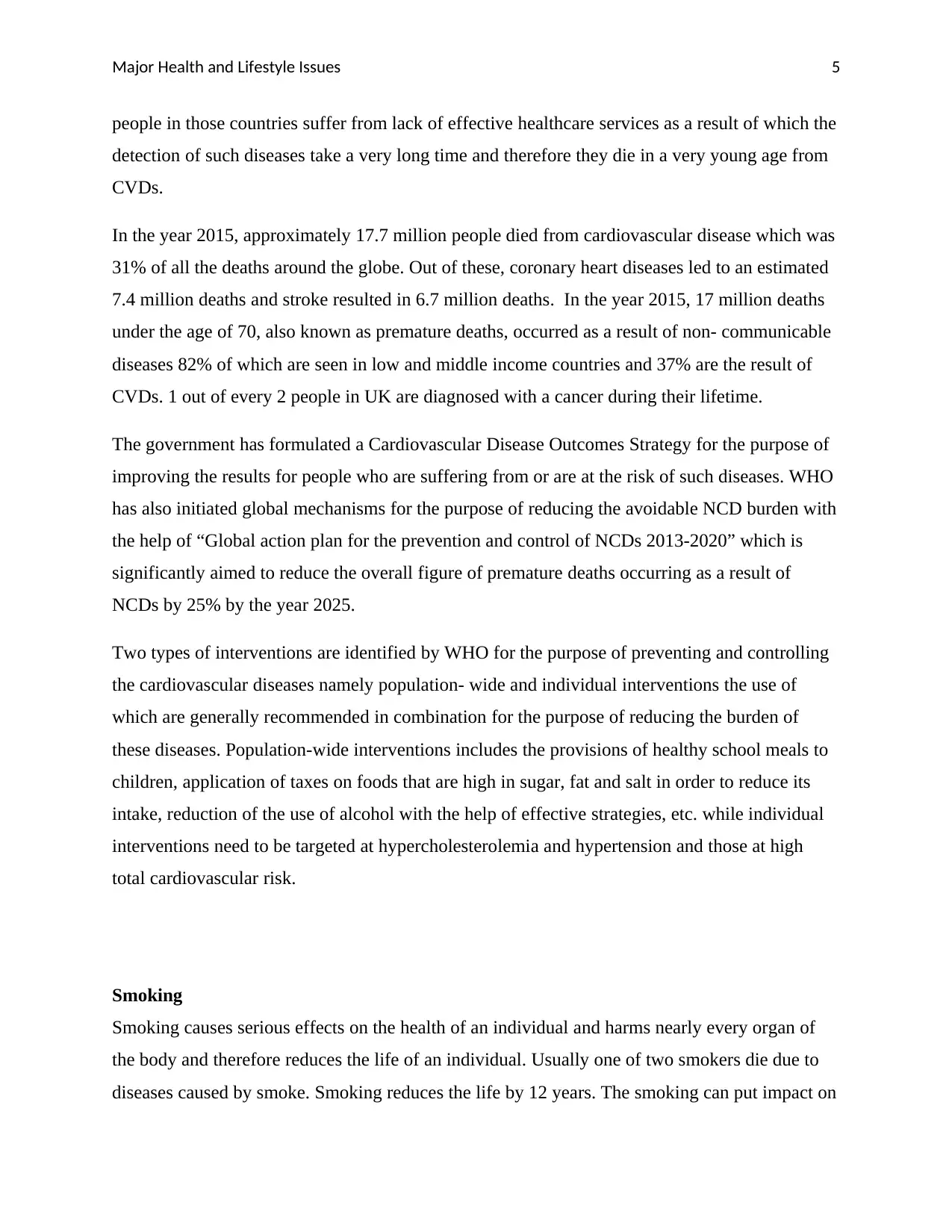
Major Health and Lifestyle Issues 5
people in those countries suffer from lack of effective healthcare services as a result of which the
detection of such diseases take a very long time and therefore they die in a very young age from
CVDs.
In the year 2015, approximately 17.7 million people died from cardiovascular disease which was
31% of all the deaths around the globe. Out of these, coronary heart diseases led to an estimated
7.4 million deaths and stroke resulted in 6.7 million deaths. In the year 2015, 17 million deaths
under the age of 70, also known as premature deaths, occurred as a result of non- communicable
diseases 82% of which are seen in low and middle income countries and 37% are the result of
CVDs. 1 out of every 2 people in UK are diagnosed with a cancer during their lifetime.
The government has formulated a Cardiovascular Disease Outcomes Strategy for the purpose of
improving the results for people who are suffering from or are at the risk of such diseases. WHO
has also initiated global mechanisms for the purpose of reducing the avoidable NCD burden with
the help of “Global action plan for the prevention and control of NCDs 2013-2020” which is
significantly aimed to reduce the overall figure of premature deaths occurring as a result of
NCDs by 25% by the year 2025.
Two types of interventions are identified by WHO for the purpose of preventing and controlling
the cardiovascular diseases namely population- wide and individual interventions the use of
which are generally recommended in combination for the purpose of reducing the burden of
these diseases. Population-wide interventions includes the provisions of healthy school meals to
children, application of taxes on foods that are high in sugar, fat and salt in order to reduce its
intake, reduction of the use of alcohol with the help of effective strategies, etc. while individual
interventions need to be targeted at hypercholesterolemia and hypertension and those at high
total cardiovascular risk.
Smoking
Smoking causes serious effects on the health of an individual and harms nearly every organ of
the body and therefore reduces the life of an individual. Usually one of two smokers die due to
diseases caused by smoke. Smoking reduces the life by 12 years. The smoking can put impact on
people in those countries suffer from lack of effective healthcare services as a result of which the
detection of such diseases take a very long time and therefore they die in a very young age from
CVDs.
In the year 2015, approximately 17.7 million people died from cardiovascular disease which was
31% of all the deaths around the globe. Out of these, coronary heart diseases led to an estimated
7.4 million deaths and stroke resulted in 6.7 million deaths. In the year 2015, 17 million deaths
under the age of 70, also known as premature deaths, occurred as a result of non- communicable
diseases 82% of which are seen in low and middle income countries and 37% are the result of
CVDs. 1 out of every 2 people in UK are diagnosed with a cancer during their lifetime.
The government has formulated a Cardiovascular Disease Outcomes Strategy for the purpose of
improving the results for people who are suffering from or are at the risk of such diseases. WHO
has also initiated global mechanisms for the purpose of reducing the avoidable NCD burden with
the help of “Global action plan for the prevention and control of NCDs 2013-2020” which is
significantly aimed to reduce the overall figure of premature deaths occurring as a result of
NCDs by 25% by the year 2025.
Two types of interventions are identified by WHO for the purpose of preventing and controlling
the cardiovascular diseases namely population- wide and individual interventions the use of
which are generally recommended in combination for the purpose of reducing the burden of
these diseases. Population-wide interventions includes the provisions of healthy school meals to
children, application of taxes on foods that are high in sugar, fat and salt in order to reduce its
intake, reduction of the use of alcohol with the help of effective strategies, etc. while individual
interventions need to be targeted at hypercholesterolemia and hypertension and those at high
total cardiovascular risk.
Smoking
Smoking causes serious effects on the health of an individual and harms nearly every organ of
the body and therefore reduces the life of an individual. Usually one of two smokers die due to
diseases caused by smoke. Smoking reduces the life by 12 years. The smoking can put impact on

Major Health and Lifestyle Issues 6
brain, skin, mouth, lungs, immune system and heart. The smoking do not just effects lungs, it
affects the whole body too. It is the most common form of recreational drug use and includes
every form of smoking including cigarette smoking, cigar smoking, pipe smoking, etc. The most
popular form is tobacco smoking and is practiced by millions around the globe. Cannabis and
opium are the other less common drugs used for smoking.
In order to deal with the symptoms of post-traumatic stress disorder (PTSD), stress faced in the
day to day life and to handle the negative moods people engage themselves in smoking.
Therefore, with the view to experience pleasure or coping up with the social situations people
use tobacco and then face the inability to find the reasons for quitting it. The symptoms of
smoking and associated diseases include loss of smell and taste, cold feet and hand, yellow teeth
and bad breath, reduced oxygen levels in blood, facing difficulty in breathing, etc.
In the year 2015, all around the globe more than 1.1 billion people were estimated to be
practicing smoking, primarily tobacco. However, in the year 2016, nearly 15.5% of the adults
were surveyed to be smoking in UK which has significantly reduced in comparison with 19.9%
smoking prevalence in the year 2010. Also 17.7% men were practicing smoking which was
higher as compared to 14.1% of women.
Smoking results in severe addiction to nicotine, respiratory and non-respiratory effects and the
related risk of other drug usage among young people and are the short term consequences on
health. Long term consequences on health include the reduction on the rate of lung growth and
the resulted lower level functioning of the lungs in comparison to those persons who have never
smoked. It is also seen that the smokers suffers from pancreatic cancer. The persons who do not
inhale smoke faces more of mouth cancer.
Smoking gives birth to worst diseases such as lung cancer, chronic obstructive pulmonary
disease, heart disease, stroke, asthma and reproductive side effects in women, premature birth,
disabilities, blindness, cataract and cervix cancer. According to American lung association, the
smoke inhaled by cigarette contains 600 ingredients. When these ingredients are burn, they
produce 7000 chemicals.
The Department of Health has initiated a program known as Towards a Smoke free Generation-
A Tobacco Control Plan for England. The plan aims at achieving a complete smoke free
brain, skin, mouth, lungs, immune system and heart. The smoking do not just effects lungs, it
affects the whole body too. It is the most common form of recreational drug use and includes
every form of smoking including cigarette smoking, cigar smoking, pipe smoking, etc. The most
popular form is tobacco smoking and is practiced by millions around the globe. Cannabis and
opium are the other less common drugs used for smoking.
In order to deal with the symptoms of post-traumatic stress disorder (PTSD), stress faced in the
day to day life and to handle the negative moods people engage themselves in smoking.
Therefore, with the view to experience pleasure or coping up with the social situations people
use tobacco and then face the inability to find the reasons for quitting it. The symptoms of
smoking and associated diseases include loss of smell and taste, cold feet and hand, yellow teeth
and bad breath, reduced oxygen levels in blood, facing difficulty in breathing, etc.
In the year 2015, all around the globe more than 1.1 billion people were estimated to be
practicing smoking, primarily tobacco. However, in the year 2016, nearly 15.5% of the adults
were surveyed to be smoking in UK which has significantly reduced in comparison with 19.9%
smoking prevalence in the year 2010. Also 17.7% men were practicing smoking which was
higher as compared to 14.1% of women.
Smoking results in severe addiction to nicotine, respiratory and non-respiratory effects and the
related risk of other drug usage among young people and are the short term consequences on
health. Long term consequences on health include the reduction on the rate of lung growth and
the resulted lower level functioning of the lungs in comparison to those persons who have never
smoked. It is also seen that the smokers suffers from pancreatic cancer. The persons who do not
inhale smoke faces more of mouth cancer.
Smoking gives birth to worst diseases such as lung cancer, chronic obstructive pulmonary
disease, heart disease, stroke, asthma and reproductive side effects in women, premature birth,
disabilities, blindness, cataract and cervix cancer. According to American lung association, the
smoke inhaled by cigarette contains 600 ingredients. When these ingredients are burn, they
produce 7000 chemicals.
The Department of Health has initiated a program known as Towards a Smoke free Generation-
A Tobacco Control Plan for England. The plan aims at achieving a complete smoke free
Paraphrase This Document
Need a fresh take? Get an instant paraphrase of this document with our AI Paraphraser
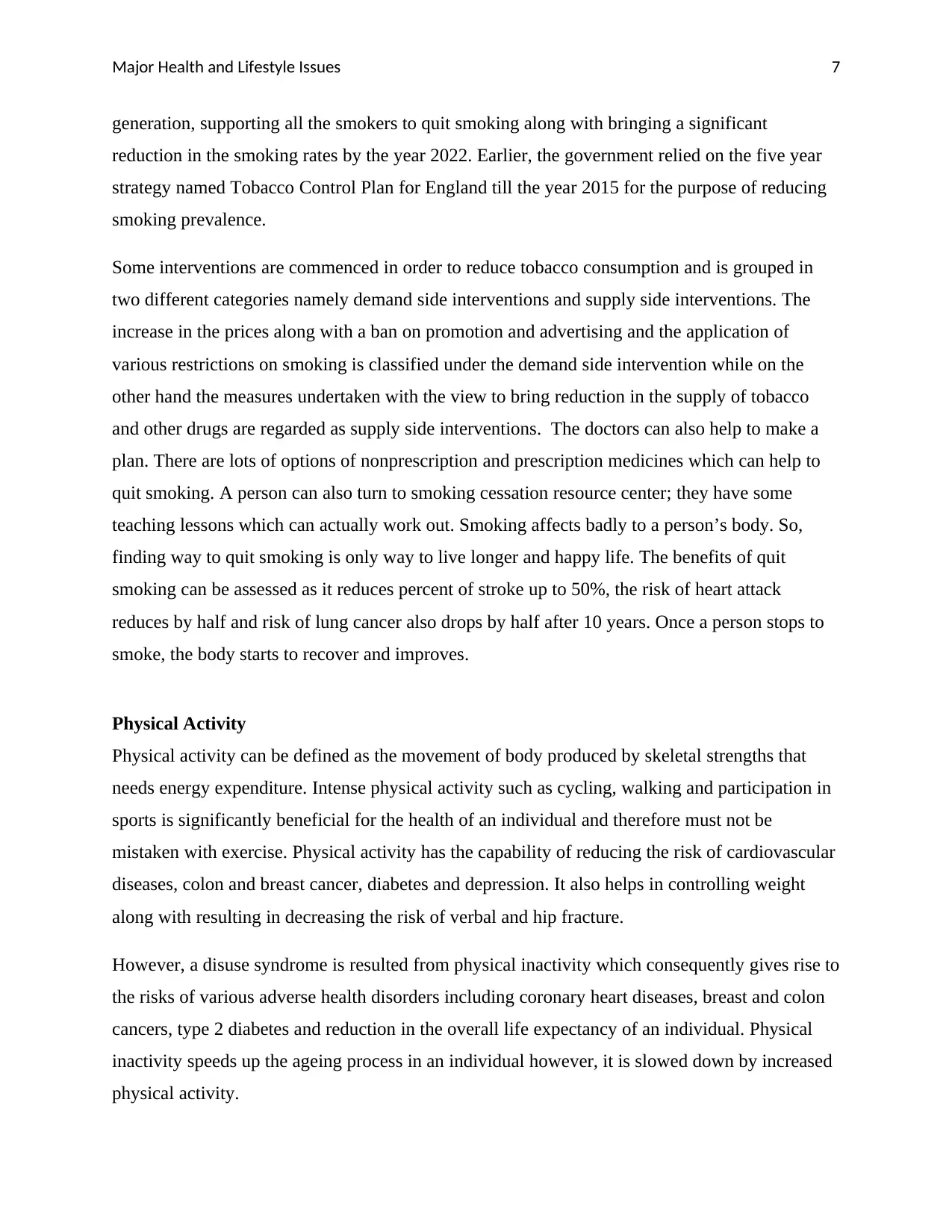
Major Health and Lifestyle Issues 7
generation, supporting all the smokers to quit smoking along with bringing a significant
reduction in the smoking rates by the year 2022. Earlier, the government relied on the five year
strategy named Tobacco Control Plan for England till the year 2015 for the purpose of reducing
smoking prevalence.
Some interventions are commenced in order to reduce tobacco consumption and is grouped in
two different categories namely demand side interventions and supply side interventions. The
increase in the prices along with a ban on promotion and advertising and the application of
various restrictions on smoking is classified under the demand side intervention while on the
other hand the measures undertaken with the view to bring reduction in the supply of tobacco
and other drugs are regarded as supply side interventions. The doctors can also help to make a
plan. There are lots of options of nonprescription and prescription medicines which can help to
quit smoking. A person can also turn to smoking cessation resource center; they have some
teaching lessons which can actually work out. Smoking affects badly to a person’s body. So,
finding way to quit smoking is only way to live longer and happy life. The benefits of quit
smoking can be assessed as it reduces percent of stroke up to 50%, the risk of heart attack
reduces by half and risk of lung cancer also drops by half after 10 years. Once a person stops to
smoke, the body starts to recover and improves.
Physical Activity
Physical activity can be defined as the movement of body produced by skeletal strengths that
needs energy expenditure. Intense physical activity such as cycling, walking and participation in
sports is significantly beneficial for the health of an individual and therefore must not be
mistaken with exercise. Physical activity has the capability of reducing the risk of cardiovascular
diseases, colon and breast cancer, diabetes and depression. It also helps in controlling weight
along with resulting in decreasing the risk of verbal and hip fracture.
However, a disuse syndrome is resulted from physical inactivity which consequently gives rise to
the risks of various adverse health disorders including coronary heart diseases, breast and colon
cancers, type 2 diabetes and reduction in the overall life expectancy of an individual. Physical
inactivity speeds up the ageing process in an individual however, it is slowed down by increased
physical activity.
generation, supporting all the smokers to quit smoking along with bringing a significant
reduction in the smoking rates by the year 2022. Earlier, the government relied on the five year
strategy named Tobacco Control Plan for England till the year 2015 for the purpose of reducing
smoking prevalence.
Some interventions are commenced in order to reduce tobacco consumption and is grouped in
two different categories namely demand side interventions and supply side interventions. The
increase in the prices along with a ban on promotion and advertising and the application of
various restrictions on smoking is classified under the demand side intervention while on the
other hand the measures undertaken with the view to bring reduction in the supply of tobacco
and other drugs are regarded as supply side interventions. The doctors can also help to make a
plan. There are lots of options of nonprescription and prescription medicines which can help to
quit smoking. A person can also turn to smoking cessation resource center; they have some
teaching lessons which can actually work out. Smoking affects badly to a person’s body. So,
finding way to quit smoking is only way to live longer and happy life. The benefits of quit
smoking can be assessed as it reduces percent of stroke up to 50%, the risk of heart attack
reduces by half and risk of lung cancer also drops by half after 10 years. Once a person stops to
smoke, the body starts to recover and improves.
Physical Activity
Physical activity can be defined as the movement of body produced by skeletal strengths that
needs energy expenditure. Intense physical activity such as cycling, walking and participation in
sports is significantly beneficial for the health of an individual and therefore must not be
mistaken with exercise. Physical activity has the capability of reducing the risk of cardiovascular
diseases, colon and breast cancer, diabetes and depression. It also helps in controlling weight
along with resulting in decreasing the risk of verbal and hip fracture.
However, a disuse syndrome is resulted from physical inactivity which consequently gives rise to
the risks of various adverse health disorders including coronary heart diseases, breast and colon
cancers, type 2 diabetes and reduction in the overall life expectancy of an individual. Physical
inactivity speeds up the ageing process in an individual however, it is slowed down by increased
physical activity.
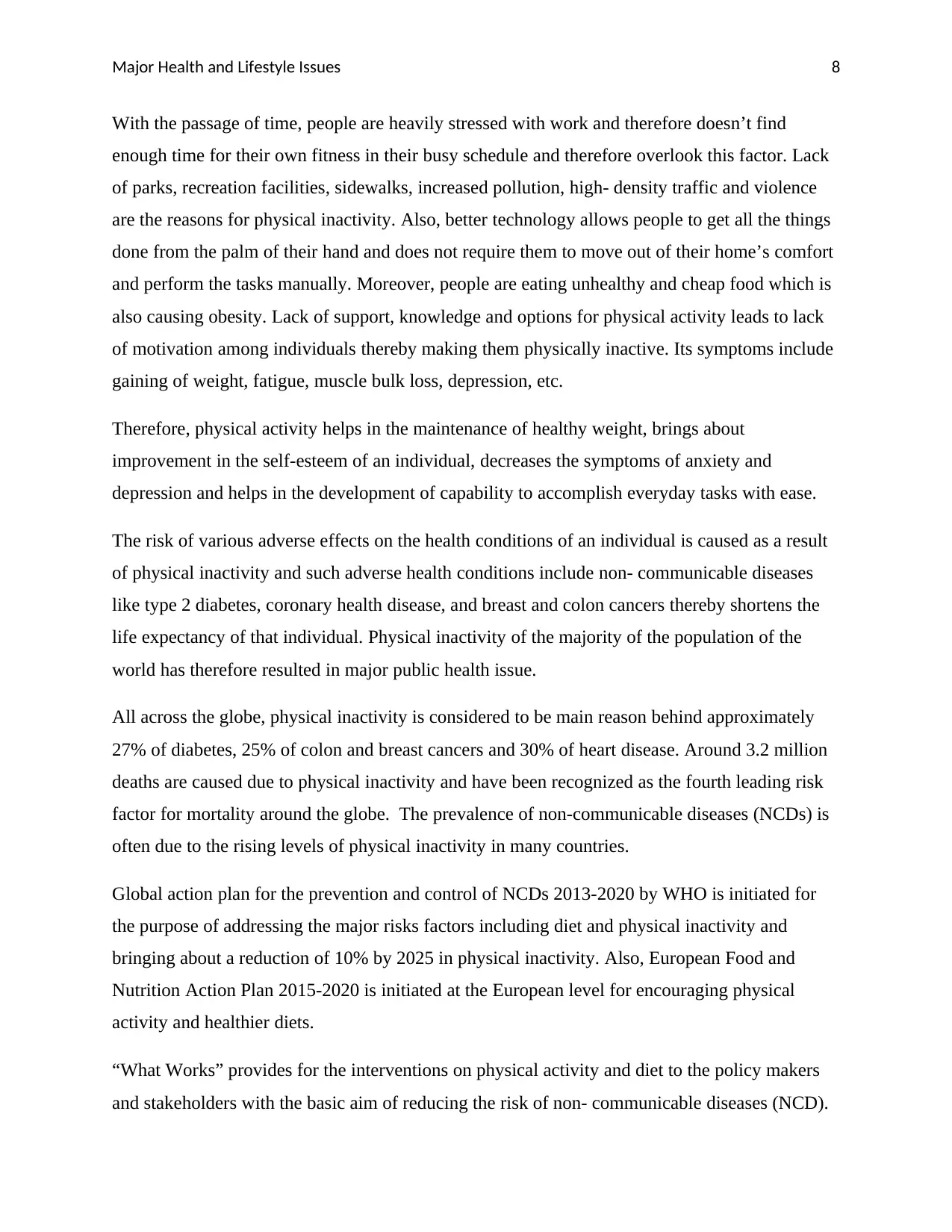
Major Health and Lifestyle Issues 8
With the passage of time, people are heavily stressed with work and therefore doesn’t find
enough time for their own fitness in their busy schedule and therefore overlook this factor. Lack
of parks, recreation facilities, sidewalks, increased pollution, high- density traffic and violence
are the reasons for physical inactivity. Also, better technology allows people to get all the things
done from the palm of their hand and does not require them to move out of their home’s comfort
and perform the tasks manually. Moreover, people are eating unhealthy and cheap food which is
also causing obesity. Lack of support, knowledge and options for physical activity leads to lack
of motivation among individuals thereby making them physically inactive. Its symptoms include
gaining of weight, fatigue, muscle bulk loss, depression, etc.
Therefore, physical activity helps in the maintenance of healthy weight, brings about
improvement in the self-esteem of an individual, decreases the symptoms of anxiety and
depression and helps in the development of capability to accomplish everyday tasks with ease.
The risk of various adverse effects on the health conditions of an individual is caused as a result
of physical inactivity and such adverse health conditions include non- communicable diseases
like type 2 diabetes, coronary health disease, and breast and colon cancers thereby shortens the
life expectancy of that individual. Physical inactivity of the majority of the population of the
world has therefore resulted in major public health issue.
All across the globe, physical inactivity is considered to be main reason behind approximately
27% of diabetes, 25% of colon and breast cancers and 30% of heart disease. Around 3.2 million
deaths are caused due to physical inactivity and have been recognized as the fourth leading risk
factor for mortality around the globe. The prevalence of non-communicable diseases (NCDs) is
often due to the rising levels of physical inactivity in many countries.
Global action plan for the prevention and control of NCDs 2013-2020 by WHO is initiated for
the purpose of addressing the major risks factors including diet and physical inactivity and
bringing about a reduction of 10% by 2025 in physical inactivity. Also, European Food and
Nutrition Action Plan 2015-2020 is initiated at the European level for encouraging physical
activity and healthier diets.
“What Works” provides for the interventions on physical activity and diet to the policy makers
and stakeholders with the basic aim of reducing the risk of non- communicable diseases (NCD).
With the passage of time, people are heavily stressed with work and therefore doesn’t find
enough time for their own fitness in their busy schedule and therefore overlook this factor. Lack
of parks, recreation facilities, sidewalks, increased pollution, high- density traffic and violence
are the reasons for physical inactivity. Also, better technology allows people to get all the things
done from the palm of their hand and does not require them to move out of their home’s comfort
and perform the tasks manually. Moreover, people are eating unhealthy and cheap food which is
also causing obesity. Lack of support, knowledge and options for physical activity leads to lack
of motivation among individuals thereby making them physically inactive. Its symptoms include
gaining of weight, fatigue, muscle bulk loss, depression, etc.
Therefore, physical activity helps in the maintenance of healthy weight, brings about
improvement in the self-esteem of an individual, decreases the symptoms of anxiety and
depression and helps in the development of capability to accomplish everyday tasks with ease.
The risk of various adverse effects on the health conditions of an individual is caused as a result
of physical inactivity and such adverse health conditions include non- communicable diseases
like type 2 diabetes, coronary health disease, and breast and colon cancers thereby shortens the
life expectancy of that individual. Physical inactivity of the majority of the population of the
world has therefore resulted in major public health issue.
All across the globe, physical inactivity is considered to be main reason behind approximately
27% of diabetes, 25% of colon and breast cancers and 30% of heart disease. Around 3.2 million
deaths are caused due to physical inactivity and have been recognized as the fourth leading risk
factor for mortality around the globe. The prevalence of non-communicable diseases (NCDs) is
often due to the rising levels of physical inactivity in many countries.
Global action plan for the prevention and control of NCDs 2013-2020 by WHO is initiated for
the purpose of addressing the major risks factors including diet and physical inactivity and
bringing about a reduction of 10% by 2025 in physical inactivity. Also, European Food and
Nutrition Action Plan 2015-2020 is initiated at the European level for encouraging physical
activity and healthier diets.
“What Works” provides for the interventions on physical activity and diet to the policy makers
and stakeholders with the basic aim of reducing the risk of non- communicable diseases (NCD).
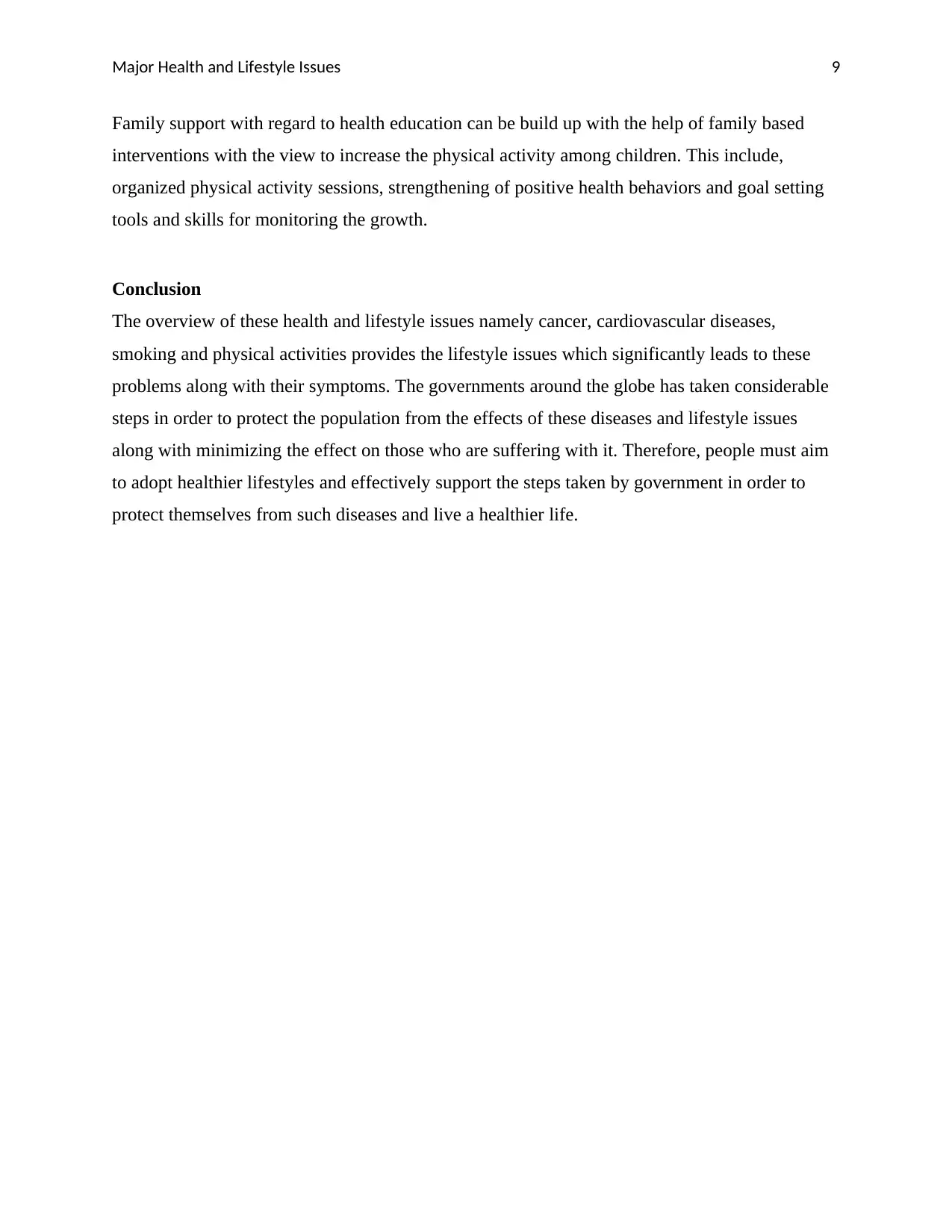
Major Health and Lifestyle Issues 9
Family support with regard to health education can be build up with the help of family based
interventions with the view to increase the physical activity among children. This include,
organized physical activity sessions, strengthening of positive health behaviors and goal setting
tools and skills for monitoring the growth.
Conclusion
The overview of these health and lifestyle issues namely cancer, cardiovascular diseases,
smoking and physical activities provides the lifestyle issues which significantly leads to these
problems along with their symptoms. The governments around the globe has taken considerable
steps in order to protect the population from the effects of these diseases and lifestyle issues
along with minimizing the effect on those who are suffering with it. Therefore, people must aim
to adopt healthier lifestyles and effectively support the steps taken by government in order to
protect themselves from such diseases and live a healthier life.
Family support with regard to health education can be build up with the help of family based
interventions with the view to increase the physical activity among children. This include,
organized physical activity sessions, strengthening of positive health behaviors and goal setting
tools and skills for monitoring the growth.
Conclusion
The overview of these health and lifestyle issues namely cancer, cardiovascular diseases,
smoking and physical activities provides the lifestyle issues which significantly leads to these
problems along with their symptoms. The governments around the globe has taken considerable
steps in order to protect the population from the effects of these diseases and lifestyle issues
along with minimizing the effect on those who are suffering with it. Therefore, people must aim
to adopt healthier lifestyles and effectively support the steps taken by government in order to
protect themselves from such diseases and live a healthier life.
Secure Best Marks with AI Grader
Need help grading? Try our AI Grader for instant feedback on your assignments.

Major Health and Lifestyle Issues 10
References
Ewles, L. 2005. Key Topics in Public Health: Essential Briefings on Prevention and Health
Promotion. Elsevier Health Sciences.
Naidoo, J. and Wills, J. 2010. Developing Practice for Public Health and Health Promotion.
Elsevier Health Sciences.
References
Ewles, L. 2005. Key Topics in Public Health: Essential Briefings on Prevention and Health
Promotion. Elsevier Health Sciences.
Naidoo, J. and Wills, J. 2010. Developing Practice for Public Health and Health Promotion.
Elsevier Health Sciences.
1 out of 11
Related Documents
Your All-in-One AI-Powered Toolkit for Academic Success.
+13062052269
info@desklib.com
Available 24*7 on WhatsApp / Email
![[object Object]](/_next/static/media/star-bottom.7253800d.svg)
Unlock your academic potential
© 2024 | Zucol Services PVT LTD | All rights reserved.




